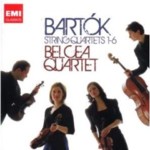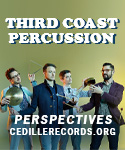The Belcea Quartet’s collective sense of character and technical polish serve Bartók’s quartets well, if not with ideal consistency. They execute certain details in ways that give familiar passages new meaning, yet sometimes miss interpretive opportunities that other foursomes relish. For example, does the violins’ coy, nearly threadbare tone in the First Quartet’s introduction truly jibe with Bartók’s molto espressivo marking? On the other hand, each instrument’s solo espressivo lines clearly stand out in the four-part texture, while the rhapsodic descending second violin and viola passage against the cello’s open fifth is appropriately supple, free-flowing, and marvelously synchronized. However, the Belceas do not really bring off the second-movement opening’s gradual accelerando, nor do they serve up the kind of rhythmic spark and tonal variety we usually expect in the Allegretto.
The same problems bring the Second Quartet’s central Allegro molto capriccioso down to earth, in contrast to the Takács Quartet’s cleaner, more supple execution. Yet in the final movement the Belceas imbue the extensive muted passages with telling color and nuance. The terse, compact Third Quartet receives a focused and tightly knit performance. My only half-quibble concerns the second part’s coda, where the players brutalize the marcatissimo gestures to the point where it’s difficult to ascertain the actual pitches.
Perhaps Fourth and Fifth Quartets encompass the Belcea’s best playing in the cycle. The Fourth’s first-movement glissandos stand out for their utter synchronicity and sense of musical shape as opposed to sound effects. The Prestissimo goes like the wind, yet every slur and accent clearly and cleanly speaks, while the players’ unpressured, conversational lilt brings out the celebrated pizzicato movement’s subtle wit. If the Belceas’ easy virtuosity and light yet colorful sonorities impart a jazzy subtext to the Fifth Quartet’s “Alla bulgarese” Scherzo, the finale’s rhythmic ferocity suggests unadulterated “hip-hop” next to the Takács’ equally brisk but more relaxed “be-bop”.
Although each of the Sixth Quartet’s slow Mesto introductions is shaped with great care, certain passages find the players pushing their tone past the blurry line that separates aggressive and ugly, such as the first movement’s pesante unisons and the second movement’s hair-trigger execution of the obsessive dotted march rhythms. Regarding the Burletta, refer back to my “missed opportunities” observation when comparing the Belcea violinists’ relatively careful quarter-tone slides against the Takács or Alban Berg Quartet’s elemental snarls. The Belcea Quartet’s Bartók may not add up to a first choice reference edition, yet collectors won’t want to miss its finest moments.
































